LITTLE ROCK — Aaron Mastropaolo fancies himself a tour guide for neophyte beertasters sampling the wares of home-brewing aficionados.
“I can find a beer that you will like,” he declared Saturday as judging began at the third annual All-American Brew Off.
Mastropaolo first questions tasters whether their preferences for a cold one fall on the sweet or “hoppy” end of the spectrum, and whether they prefer light or dark beers.
Tasters could sample suds of every imaginable variety, from India Pale Ales, known as “IPAs,” to one recipe that featured smoked grains, as they met at Fort Smith’s Aspen Hotel.
The contest, sponsored by the River Valley Ale Raisers home-brew club, drew 69 entries from Arkansas and beyond as enthusiasts sought first-place and “Best of Show” honors Saturday.
Twenty-one judges wellschooled in terms such as “mouthfeel” and “tight sediment” were on hand Saturday. One was so accomplished that his mere presence rendered Saturday’s contest “a sanctioned event,” said event coordinator Jed Reinhard.
Experts like Mastropaolo were on hand to delight visitors with bits of history like this: The India Pale Ales came to be known for their “hoppy” flavor for a practical reason. The British found they needed to add extra hops as a preservative before shipping the drink long distances such as to the British colony of India, and the world came to love the taste.
Amateur tasters acquainted with the wine-tasting practice of not swallowing samples had an adjustment to make Saturday.
“We don’t spit,” Reinhard said.
Instead, brew lovers had the choice of enjoying the entire sample or making use of strategically placed buckets around the room.
For beer judges, palate fatigue is a real danger, so a first-round elimination tasting was held two weeks before Saturday’s competition.
Nowadays, anyone interested in becoming a home brewer can hop on the Internet to find how-to information for getting started, or take advantage of the experience of bloggers.
Still, for Reinhard, a Fort Smith resident who got started more than two decades ago at age 28, it wasn’t that difficult even back then.
A friend invited him over to sample a batch of homemade suds. Hearing about the beermaking process reminded him of his studies at Arkansas State University, where he earned his chemistry degree. After all, microbrewing is all about chemistry.
“I said, ‘I can do that,’” Reinhard recalled.
He got a copy of Charlie Papazian’s Joy of Brewing — now in its third edition as The Complete Joy of Home Brewing — for guidance.
“All beers have four ingredients,” Reinhard said, though the simplicity ends there. The four must-haves are a malted grain, water, yeast and hops, a pinecone-like flower which adds the necessary bitterness.
For 15 years, Reinhard focused on perfecting five recipes, naming them simply 1 through 5. It wasn’t until seven years ago that he began learning about competitive brewing.
Not every beverage showcased at Saturday’s event was a true beer. Some were categorized as hard lemonades and others as honey-wines known as meads.
For instance, a hard limeade on tap as part of the club’s own offerings was a sensation.
“I think they nailed it,” said Brent Kerr of Fort Smith, who is usually no fan of hard lemonades.
Its taste was pleasantly sweet without being overly so, and there wasn’t the slightest hint of alcohol since the alcohol content was a low 4 to 4.5 percent.
Mastropaolo noted the hard limeade isn’t a beer because it lacks grain and hops.
The limeade’s maker, Pat Pursel of Prairie Grove, said his wife’s tastes strongly influence his choices.
“I was trying to get it more ... a little on the ‘girlie’ side for the girls,” Pursel said.
“You want the recipe?” he said.
Six cans of frozen lemonade, four cans of frozen limeade, 5 pounds of sugar, a pinch of champagne yeast and a short jar of maraschino juice, sans the cherries.
“I didn’t want to get it too pink,” Pursel said, before continuing with his recipe: “Let it ferment out for 3 weeks.”
Pursel also offered up a cream ale Saturday.
“It’s actually an old recipe from, like, pre-Prohibition,” he said.
Home brewers tend to lean more toward ales because lagers can require a cold-fermentation process that is hard to achieve, Pursel said.
Who can keep 10 gallons of brew at near-freezing temperatures for three weeks? Not many people, he said.
At the booth of Hellbender Meadery LLC of Rogersville, Mo., (the “booth” consisted of a cooler rigged with translucent pipe snaking through crushed ice to a pair of exterior taps), Jhett Collins fielded a barrage of questions from those in attendance.
Collins had all the answers, which he provided while interjecting quicker replies to queries about the green-teaand-mint mead and the ginger mead folks were sampling.
A taster sampling the ginger mead offered an extremely critical review as Collins was answering questions. Turns out, the critic was Hellbender’s head brewer — or meadmaker — Todd Rock.
Rock, sporting a bandana over his long curly locks, said his extensive sensory training and studies at the University of California-Davis mean his tasting experience is far different from that of average tasters.
“When something’s wrong, it just bugs the crap out of me,” he said.
Arkansas, Pages 18 on 07/29/2012
